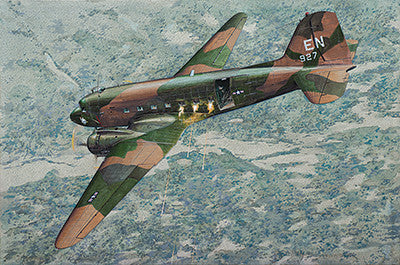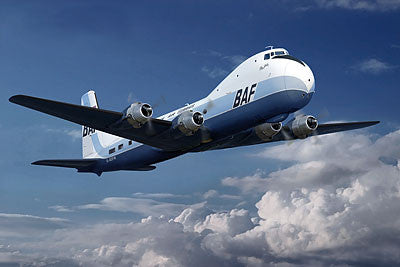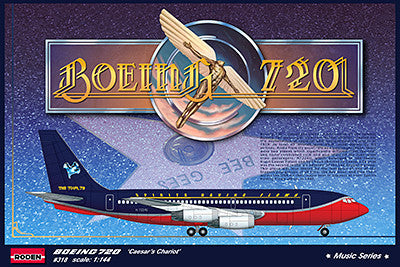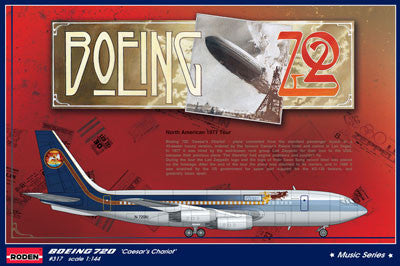
Roden Aircraft 1/144 B307 Stratoliner TWA Passenger Airliner Kit
Estimated Shipping: 2-3 Business Days
ROD-339In the mid-1930s, in the wake of the rapid growth in passenger air travel, the Boeing Aircraft Company, while busy with the design of a modern four-engine bomber, worked simultaneously on the creation of a new four-engine aircraft, purposed for civil aviation.
Innovative engineering directly affected the design of the aircraft fuselage - for the first time in a machine of this type, a pressurized cabin was utilized, which enabled a significant increase in altitude in flight, allowing greater safety and minimization of collision with thunderstorms, which flights were affected by at lower levels. The new aircraft, according to designers, could safely fly at an altitude of more than 7,500 meters, where the more dangerous atmospheric phenomena were absent.
The first flight of the aircraft took place on the last day of 1938, but shortly afterward a catastrophe resulted in the deaths of not only the pilot but also representatives of a potential buyer, KLM, and work on the aircraft's design had to be re-done for safety reasons.
The first customer for the new aircraft was the famous Pan American Airways, which received three machines. Six more were ordered by another well-known airline of the time, Transcontinental and Western Air (TWA), but due to financial disagreements, the transfer of already built airframes was the subject of litigation. The famous aviation enthusiast and billionaire Howard Hughes, who became interested in the promising new airplane, devised an original and easy way out of the situation for himself and others - he bought a controlling stake in Boeing. Five units were completed and handed over to the new owner, while another aircraft was privately owned by Hughes, and named The Flying Penthouse. The type was also named Stratoliner for the first time in the history of American civil aviation. The aircraft was comfortable enough and could carry 33 passengers in a seated position, or 16 in folding comfortable berths during long transcontinental night flights. In addition to the forced ventilation system and the maintenance of normal pressure, the Stratoliner had many other interesting innovations. Considerable attention was paid to the issue of flight comfort, so that even a spacious women's lavatory was installed, with a separate toilet located in it.
The commercial operation of TWA's Stratoliner began in June 1940 (Pan American had started earlier, operating flights from Florida to the Caribbean as well to Mexico and Brazil) from New York to California. Their commercial use continued until the end of 1941, when after the entry of the United States into World War II, all Stratoliners were requisitioned and transferred to the Air Force, designated the C-75. For military service, the pressurized cabin system was dismantled as unnecessary, and the aircraft no longer had such high altitude capabilities as before. But it allowed for the installation of additional fuel tanks, which increased the flight range by 1,600 km. Its combat service was marked by some interesting episodes - for example, the C-75 carried the surviving Doolittle Raid pilots (including James Doolittle himself) from deep continental China to the United States.
After the war, all five machines were demobilized and returned to their original owners, TWA, having previously been upgraded. The upgrade cost TWA a pretty substantial sum of $2 million for the 5 planes, $400,000 for each plane. It is unknown whether TWA would have recovered these funds if it had not been for the unpredictable situation with the newest Lockheed Constellation, the new flagship of TWA, which, after several unfortunate incidents in early 1946, was dropped from flight operations until investigations were completed. At this time, it was the Stratoliner that carried out the major TWA transportation.
The advent of the Douglas DC-4 brought an end to the operation of the Stratoliner by TWA; soon, they were all resold to the French carrier Aigle Azur Transports Aeriens and their subsequent airline service continued mainly in the southeastern colonial possessions of France. Individual aircraft flew until the mid-1970s and were then decommissioned solely for safety and age reasons.
Innovative engineering directly affected the design of the aircraft fuselage - for the first time in a machine of this type, a pressurized cabin was utilized, which enabled a significant increase in altitude in flight, allowing greater safety and minimization of collision with thunderstorms, which flights were affected by at lower levels. The new aircraft, according to designers, could safely fly at an altitude of more than 7,500 meters, where the more dangerous atmospheric phenomena were absent.
The first flight of the aircraft took place on the last day of 1938, but shortly afterward a catastrophe resulted in the deaths of not only the pilot but also representatives of a potential buyer, KLM, and work on the aircraft's design had to be re-done for safety reasons.
The first customer for the new aircraft was the famous Pan American Airways, which received three machines. Six more were ordered by another well-known airline of the time, Transcontinental and Western Air (TWA), but due to financial disagreements, the transfer of already built airframes was the subject of litigation. The famous aviation enthusiast and billionaire Howard Hughes, who became interested in the promising new airplane, devised an original and easy way out of the situation for himself and others - he bought a controlling stake in Boeing. Five units were completed and handed over to the new owner, while another aircraft was privately owned by Hughes, and named The Flying Penthouse. The type was also named Stratoliner for the first time in the history of American civil aviation. The aircraft was comfortable enough and could carry 33 passengers in a seated position, or 16 in folding comfortable berths during long transcontinental night flights. In addition to the forced ventilation system and the maintenance of normal pressure, the Stratoliner had many other interesting innovations. Considerable attention was paid to the issue of flight comfort, so that even a spacious women's lavatory was installed, with a separate toilet located in it.
The commercial operation of TWA's Stratoliner began in June 1940 (Pan American had started earlier, operating flights from Florida to the Caribbean as well to Mexico and Brazil) from New York to California. Their commercial use continued until the end of 1941, when after the entry of the United States into World War II, all Stratoliners were requisitioned and transferred to the Air Force, designated the C-75. For military service, the pressurized cabin system was dismantled as unnecessary, and the aircraft no longer had such high altitude capabilities as before. But it allowed for the installation of additional fuel tanks, which increased the flight range by 1,600 km. Its combat service was marked by some interesting episodes - for example, the C-75 carried the surviving Doolittle Raid pilots (including James Doolittle himself) from deep continental China to the United States.
After the war, all five machines were demobilized and returned to their original owners, TWA, having previously been upgraded. The upgrade cost TWA a pretty substantial sum of $2 million for the 5 planes, $400,000 for each plane. It is unknown whether TWA would have recovered these funds if it had not been for the unpredictable situation with the newest Lockheed Constellation, the new flagship of TWA, which, after several unfortunate incidents in early 1946, was dropped from flight operations until investigations were completed. At this time, it was the Stratoliner that carried out the major TWA transportation.
The advent of the Douglas DC-4 brought an end to the operation of the Stratoliner by TWA; soon, they were all resold to the French carrier Aigle Azur Transports Aeriens and their subsequent airline service continued mainly in the southeastern colonial possessions of France. Individual aircraft flew until the mid-1970s and were then decommissioned solely for safety and age reasons.






